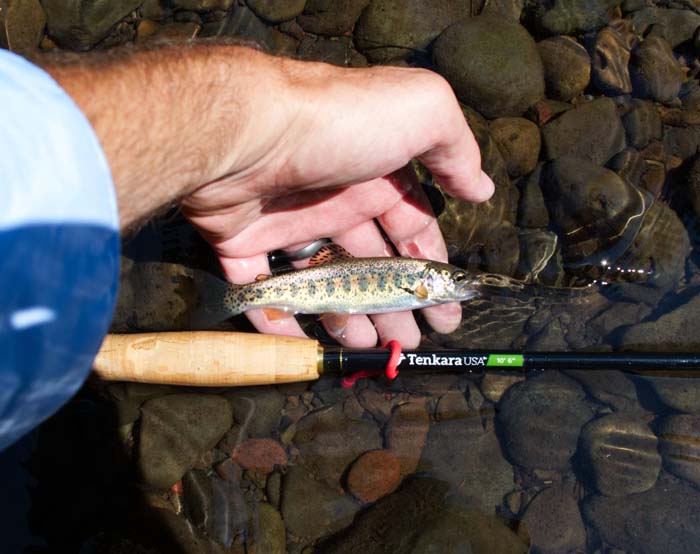Spring trout on the fly
Published 9:00 am Saturday, May 16, 2020

- A glorious rainbow trout parr that fell for a dry fly dead-drifted with a tenkara rod.
PENDLETON — My Tundra bounced up onto the old wood plank bridge. The dark planks rocked and popped beneath the weight. I was pushing the width limit. My hands, white-knuckled on the wheel, managed to avoid shredding a quarter panel against the steel rails while the Selway River boiled a bit off color below.
Trending
Upon a safe dismount, I started the climb to a trailhead where I would embark on a journey into trout country. I knew nothing of the destination, but suspected either cutthroat or rainbow. After all, it was Idaho.
Rounding a bend in the old Forest Service road revealed a breathtaking meadow reach. The stream meandered its way to the Selway through a lush carpet of brilliant green grass and forbs. Native Trillium was blooming cotton candy pink in the company of a snoozing whitetail deer. A tantalizing plunge-pool appeared dark and fishy below a cascade of boulders and log jams. My foot mashed the brake pedal. I never saw the destination trailhead.
Large caddis were hatching as I donned my waders. Ogling them lustily lulled me into a giddy, unfounded anticipation.
Trending
Early spring fishing can be a straight up crap-shoot. Steady water temperature and relatively stable flow through the winter can offer equally stable action (albeit slow at times), but as days lengthen and air temperature increases, snow melt-swollen streams begin to change the game a bit. Nevertheless, I selected a classic high mountain pairing, a size 12 caddis dropping a size 16 pheasant tail nymph. And the dice rolled.
Selecting the finest habitat set my confidence high, but the water temperature was glacial. I found the runs moving a bit too fast to present the fly well, even with a flawless dead-drift. I turned to the pocket waters and failed, then moved to the fringes where water velocity is slower with warmer temperature.
Young trout will often seek the fringes during spring high flows where holding water meets cover and food sources. With hopes high, I placed the caddis on the outside edge of a flow seam and just downstream of a boulder. At once the caddis vanished beneath the surface, the nymph taken by a young rainbow parr.
The parr life stage is physically characterized by a size range of approximately 2 to 5 inches and large “parr marks,” which are dark, oval-shaped marks along the lateral line. Parr marks serve as camouflage and are generally lost as the fish matures. In some cases, trout older than a year may retain lighter, yet obvious, parr marks.
Modern fishing emphasizes the trophy fish, but the brilliance of a young wild trout returns the angler to a universal experience. A wild trout parr is a spectacle to behold, rich and vibrant with various mottling. The white anal fin tip, the fine black speckles among an olive dorsal, and the rosy pink lateral stripe of a rainbow express perfection as only a wild fish can. With a gentle pop of the barbless hook, I sent the parr on its way. Shuffling up to another hole, I was met with an encore performance, my three-weight rod dancing under the inconspicuous weight of the tiny gem.
Mountain streams can run strong and cold in spring, but can turn on in June if the flow is fishable. The best choice in spring and early summer may be desert water, and desert streams are not to be overlooked. These little blue lines flourish in May and June with aggressive trout and abundant food. Flows are typically fishable and many of these streams lend themselves to a number of fly-fishing techniques, including traditional tenkara.
Desert streams provide prime opportunity to get creative. If you have been curious about a crack in the middle of nowhere spewing cold water through a sagebrush canyon, go for it. Seek pockets and plunge pools. Although the local fish and game office may not post anything about it, if it’s legal to fish, you may just find a new favorite stream. The Owyhee can be dynamite. What about its tributaries?
Desert lakes are ablaze in spring as well. For Lahontan cutthroat, I generally fish shorelines with scuds or buggers. If the fish are not up and cruising the shallows, they can be found deeper along shoreline boulders. A full-sinking fly line is about the only way to reach them, counting down to 20 feet or more before beginning a varied strip retrieve. Lahontans either hammer the fly or simply engulf it and just sit there, creating awkward tension. A sixth sense tells you when to set the hook. Heavy head shakes and deep runs are left to the drag.
Desert lake rainbows are cruising shallow weed beds at the edge of deep water, providing the appropriate mix of food and depth through the June time frame. Dry flies are working now and traditional tenkara flies and methods can be effective as well. When the water is cold but a hatch is on, a dry fly with a dropper nymph is a fine option as midges dominate desert lakes, but matching the hatch can be crucial. When all else fails, sink a small streamer. Never will a 15-inch trout work the drag on a five-weight fly rod like a desert lake rainbow.
Now, more than ever, you are itching to wet a fly. As a sunny day blooms, you need no excuse to shuck responsibility and undue stress for the symphonic chorus of the flush of courting songbirds, the mesmerizing roar of a stream or serenity of floating a lake as the water surface dimples from feeding trout. It’s time. Drop everything. Go fishing. And cherish the wild trout, big or small.









